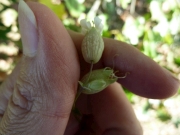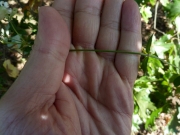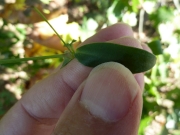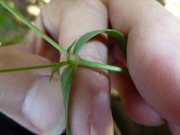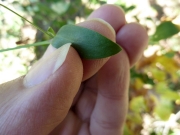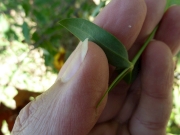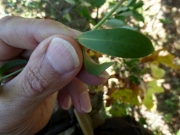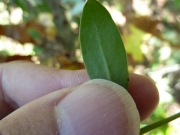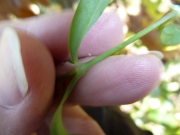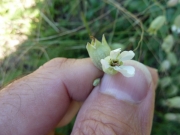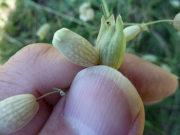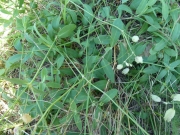Transformational Gardening
October 2011 Foraging Experiences
(Back to:
September 2011 Foraging Experiences)
(Forward to:
November 2011 Foraging Experiences)
October 1, 2011
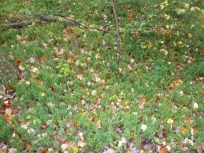
 Stiff Clubmoss (Lycopodium annotinum) has a slightly similar look to Running Clubmoss
(Lycopodium clavatum), but Running Clubmoss has several branches off of the upright
shoots. See pictures at:
http://www.transformationalgardening.com/forage/plants/lycopodium-clavatum-images.html. In
addition, Running Clubmoss has 1 to 5 Strobili growing from each long strobilus stalk. Stiff Clubmoss
has 1 to 4 strobili growing directly from the upright shoot (not a separate stalk).
Stiff Clubmoss (Lycopodium annotinum) has a slightly similar look to Running Clubmoss
(Lycopodium clavatum), but Running Clubmoss has several branches off of the upright
shoots. See pictures at:
http://www.transformationalgardening.com/forage/plants/lycopodium-clavatum-images.html. In
addition, Running Clubmoss has 1 to 5 Strobili growing from each long strobilus stalk. Stiff Clubmoss
has 1 to 4 strobili growing directly from the upright shoot (not a separate stalk).
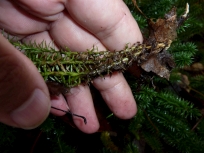
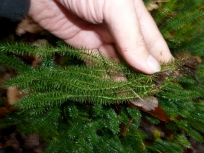 Stiff Clubmoss is very similar to Northern Interrupted Clubmoss (Lycopodium canadense).
However, Northern Interrupted Clubmoss is not listed as a separate species in the
USDA Plants Database or in the book,
Manual of Vascular Plants of Northeastern United States and Adjacent Canada. It is listed
as a separate species in the book,
Ferns of the Northeastern and Central North America (Peterson Field Guide) and
The Families of Huperziaceae and Lycopodiaceae of New England: A Taxonomic and Ecological
Reference by Arthur Haines. The strobili of Northern Interrupted Clubmoss typically grows
to no longer than 5/8 of an inch. In addition, the upper side of the leaves have numerous
stomates (pores). The leaves of Stiff Clubmoss are sparsely, but noticibly toothed. The leaves
of Northern Interrupted Clubmoss are entire (untoothed) or with very small teeth.
Stiff Clubmoss is very similar to Northern Interrupted Clubmoss (Lycopodium canadense).
However, Northern Interrupted Clubmoss is not listed as a separate species in the
USDA Plants Database or in the book,
Manual of Vascular Plants of Northeastern United States and Adjacent Canada. It is listed
as a separate species in the book,
Ferns of the Northeastern and Central North America (Peterson Field Guide) and
The Families of Huperziaceae and Lycopodiaceae of New England: A Taxonomic and Ecological
Reference by Arthur Haines. The strobili of Northern Interrupted Clubmoss typically grows
to no longer than 5/8 of an inch. In addition, the upper side of the leaves have numerous
stomates (pores). The leaves of Stiff Clubmoss are sparsely, but noticibly toothed. The leaves
of Northern Interrupted Clubmoss are entire (untoothed) or with very small teeth.
October 6, 2011
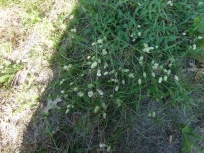
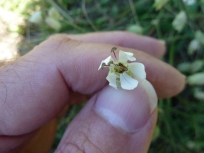

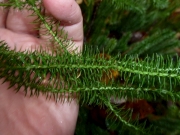

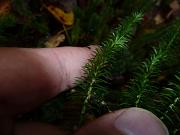

 Stiff Clubmoss (Lycopodium annotinum) has a slightly similar look to Running Clubmoss
(Lycopodium clavatum), but Running Clubmoss has several branches off of the upright
shoots. See pictures at:
http://www.transformationalgardening.com/forage/plants/lycopodium-clavatum-images.html. In
addition, Running Clubmoss has 1 to 5 Strobili growing from each long strobilus stalk. Stiff Clubmoss
has 1 to 4 strobili growing directly from the upright shoot (not a separate stalk).
Stiff Clubmoss (Lycopodium annotinum) has a slightly similar look to Running Clubmoss
(Lycopodium clavatum), but Running Clubmoss has several branches off of the upright
shoots. See pictures at:
http://www.transformationalgardening.com/forage/plants/lycopodium-clavatum-images.html. In
addition, Running Clubmoss has 1 to 5 Strobili growing from each long strobilus stalk. Stiff Clubmoss
has 1 to 4 strobili growing directly from the upright shoot (not a separate stalk).
 Stiff Clubmoss is very similar to Northern Interrupted Clubmoss (Lycopodium canadense).
However, Northern Interrupted Clubmoss is not listed as a separate species in the
USDA Plants Database or in the book,
Manual of Vascular Plants of Northeastern United States and Adjacent Canada. It is listed
as a separate species in the book,
Ferns of the Northeastern and Central North America (Peterson Field Guide) and
The Families of Huperziaceae and Lycopodiaceae of New England: A Taxonomic and Ecological
Reference by Arthur Haines. The strobili of Northern Interrupted Clubmoss typically grows
to no longer than 5/8 of an inch. In addition, the upper side of the leaves have numerous
stomates (pores). The leaves of Stiff Clubmoss are sparsely, but noticibly toothed. The leaves
of Northern Interrupted Clubmoss are entire (untoothed) or with very small teeth.
Stiff Clubmoss is very similar to Northern Interrupted Clubmoss (Lycopodium canadense).
However, Northern Interrupted Clubmoss is not listed as a separate species in the
USDA Plants Database or in the book,
Manual of Vascular Plants of Northeastern United States and Adjacent Canada. It is listed
as a separate species in the book,
Ferns of the Northeastern and Central North America (Peterson Field Guide) and
The Families of Huperziaceae and Lycopodiaceae of New England: A Taxonomic and Ecological
Reference by Arthur Haines. The strobili of Northern Interrupted Clubmoss typically grows
to no longer than 5/8 of an inch. In addition, the upper side of the leaves have numerous
stomates (pores). The leaves of Stiff Clubmoss are sparsely, but noticibly toothed. The leaves
of Northern Interrupted Clubmoss are entire (untoothed) or with very small teeth.






